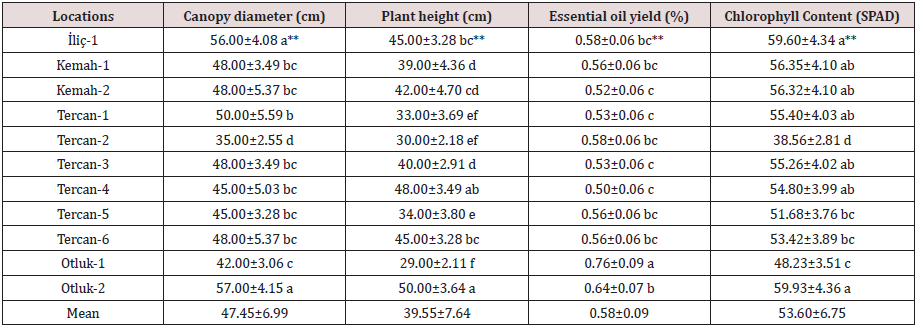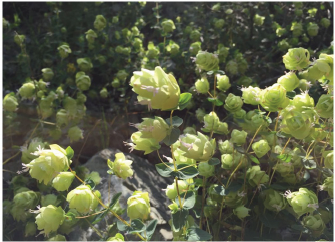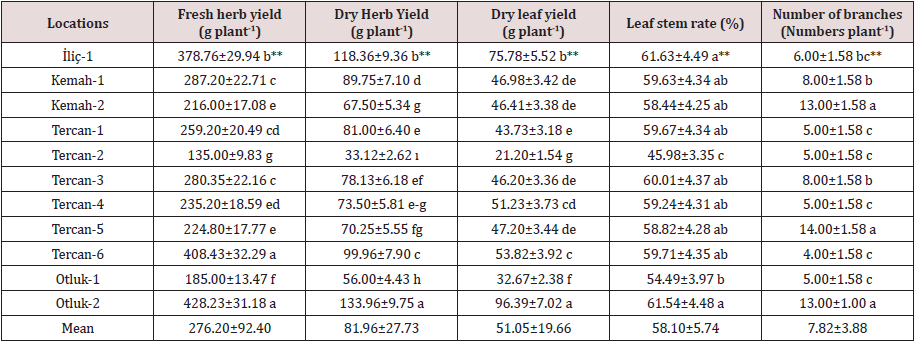
Lupine Publishers Group
Lupine Publishers
Menu
ISSN: 2637-4676
Research Article(ISSN: 2637-4676) 
Determination of Origanum acutidens (Hand.-Mazz.) Ietswaart in Erzincan Province in Turkey Volume 9 - Issue 1
Halit Karagoz1,2, Ramazan Cakmakci3 and Fazilet Parlakova Karagoz4
- 1Department of Field Crops, Faculty of Agriculture, Atatürk University, Turkey
- 2East Anatolia Agricultural Research Institute, Gezköy-Dadaskent, Turkey
- 3Department of Agronomy, Faculty of Agriculture, Çanakkale Onsekiz Mart University 17100 Çanakkale, Turkey
- 4Department of Horticulture, Faculty of Agriculture, Atatürk University, Turkey
Received: September 05, 2020; Published: September 15, 2020
Corresponding author: Fazilet Parlakova Karagoz Department of Horticulture, Faculty of Agriculture, Atatürk University, 25240 Erzurum, Turkey
DOI: 10.32474/CIACR.2020.09.000301
Abstract
This study was carried out in order to determine the existence, the some morphological parameters and essential oil rate of Origanum acutidens (Hand.-mazz.) Ietswaart (endemically grown in Turkey) populations in Erzincan province (Turkey). For this purpose, field trips were organized to all districts within the borders of Erzincan province between July 15 and August 15 and eleven genotypes having different morphology were determined in four districts with the presence of Origanum acutidens. The measurements were taken included the fresh herba yield, dry herba yield, dry leaf yield, leaf stem ratio, side branch number, canopy diameter, plant height, chlorophyll content and essential oil rates in these genotypes. There were found significant differences (p˂0.01) in all parameters except essential oil ratio and morphological variation was determined as high among Origanum acutidens populations in this province.
Keywords: Essential oil; Endemic plants; Antibacterial; Antifungal
Introduction
The word Origanum comes from the words that mean mountain ornament in Greek (oros= mountain, ganos = ornament). The genus Origanum belongs to the Lamiaceae family and is commonly known as oregano and marjoram. Origanum genus includes about 900 species in the world (Davis, [1]; Baser, [2]). Turkey is considered the gene centre of this genus because 22 species and four subspecies are represented. They are grouped into eight sections and 14 species are endemic to Turkey. Origanum acutidens (Hand.-Mazz.) Ietswaart is an endemic plant growing in the eastern part of Turkey (Bakis et al., [3]) and it is rich in carvacrol (Baser et al., [2]; Figueredo et al., [4]; Kordali et al., [5]). Origanum acutidens has very beautiful flowers with white to pale yellow or pink corollas that flower between June and August. It is a perennial herbaceous plant (Figure 1). O. acutidens grows on limestone and on non-calcareous soils, between 1000-3000 m, sometimes in shady places. O. acutidens needs very little moisture during the growing season (Davis, [1]).
This genus is rich in bitter substances and essential oils (Baytop, 1999; Esen et al., 2007; Kordali et al., 2008). It was stated that p-cymene (7.5–14.0%) and carvacrol (66.0–72.0%) were the primary components of the essential oils of O. acutidens (Baser et al., [2]; Sokmen et al., [6]; Figueredo et al.,[4]). Kordali et al. [5] reported that O. acutidens essential oil and its aromatic monoterpene components showed potent antifungal activity against plant pathogens, fungi and phytotoxic effects against A. retroflexus, R. crispus and C. Albüm (Karagoz and Parlakova Karagoz, [7]).
In parallel with the developments in the chemical sector, the manufacturing of chemical drugs has become easier, therefore interest in plant-derived components has decreased. However, the adverse effects caused by chemical drugs have recently attracted interest in plant components again (Avcı and Bayram, [8]). Nowadays, scientists are interested in plant-based drug materials because the adverse effects seen in chemical drugs are less common in plant-based drugs and disease strains are more resistant to chemical-based antibiotics (Dülger et al., [9]). The plant are grown as endemic in Turkey. Also, there are no studies covering the morphological features of this plant. The objective of this study is to gather information about of morphological changes these specie in the Erzincan province in Turkey.
Materials and Methods
Plant materials
For this purpose, field trips were organized to all districts within the borders of Erzincan province. 11 different genotypes were determined in four different districts within the boundaries Erzincan in Turkey. Plant materials were collected from natural habitat in full flowering period between August 15 and July 15 in 2016. The geographic information of the genotypes is presented in (Table 1).
Parameters Observed in the Study
15 plants from each genotype were collected from natural habitat. The measurements were taken included the the some morphological parameters and essential oil rate of Origanum acutidens (Hand.-mazz.) Ietswaart in Erzincan, Turkey. Plant height (cm): The part of the main shoot from the soil level to the end of the shoot was determined by measuring with a ruler. Canopy diameter (cm): Shadow diameter of the plants was measured by a ruler and averaged. Fresh herba yield (g plant-1): The plants were obtained by mowing at 10-15 cm soil level with garden shears. Dry herbs yield (g plant-1): The plants were obtained by drying the thyme in the shade. Dry leaf yield: The dried partridges were milled and separated from the leafs plants with a 4 mm sieve. Number of branches: It was obtained by counting the side branches on the main stem of the plant. Chlorophyll content (SPAD): It was measured by portable chlorophyll meter (Minolta SPAD-502, Osaka, Japan) (Wood et al., [10]). Essential oil rate (g ml-1): It was determined as g ml-1 by using Neo-clevenger apparatus in dried drog leaves and the data obtained were converted to %.
Statistical Analysis
Analysis of variance from SPSS 20.0 (SPSS Inc.) programme was performed on the data obtained from the study and then in conformity with Duncan’s Multiple Range Test, the means were separated. Morphological parameters was evaluated in fifteen samples from each genotype.
Results
According to the variance analysis results, the relationship between all parameters was statistically (p≤0.01) very significant. Fresh herba yield in the province of Erzincan was determined to vary between 428.23 g and 216 g. The highest fresh herba yield was measured in OTLUK-2 genotype and the lowest fresh herba yield was found in KEMAH-2 genotype. In terms of dry herba yield and dry leaf yield; while the highest genotype was determined OTLUK-2 (respectively 133.96 g plant-1 and 96.39 g plant-1) genotype, the lowest genotype was measured in TERCAN-1 (respectively 81.00 g plant-1 and 43.73 g plant-1) genotype. The highest leaf stem rate in Erzincan province was obtained from İLİC-1 (61.36%) and OTLUK-2 (61.51%) genotypes. The lowest leaf stem rate was measured in TERCAN-2 (45.98%) genotype. While the number of lateral branches in Erzincan ranged from 4 (number plant -1) to 13 (number plant-1), the highest number of lateral branches was determined in the genotypes OTTLUK-2 and KEMAH-2 (Table 2). letter at p<0.05 significance level. Values followed by different lower-case letters in a column were significantly different.
The plant crown width, known as canopy diameter, ranged from 35 to 57 cm. OTLUK-2 (57 cm) and ILIC-1(56 cm) were identified the highest canopy diameter genotypes, while the lowest canopy diameter was found in TERCAN-2 (35 cm) genotype. The longest plant in this province was the OTLUK-2 genotype and the shortest plant was the TERCAN-5 genotype. Essential oil rates in Erzincan ranged from 0.5 to 0.76%. The highest essantial oil rate was measured in the OTLUK-1(0.76 %) genotype. The lowest essantial oil rate was determined in the TERCAN-4 (0.5%) genotype. The most important parameter showing the photosynthetic activity of plants is chlorophyll content. The chlorophyll content in this study was determined to vary between 59.93 and 38.56 (SPAD). The richest genotypes in terms of chlorophyll content were OTLUK-2 (59393 SPAD) and ILIC-1 (59.60 SPAD) genotypes. The lowest chlorophyll content was determined in TERCAN-2 (38,56 SPAD) genotype (Table 3). letter at p<0.05 significance level. Values followed by different lower-case letters in a column were significantly different.
Table 3: Some morphological parameters of Origanum acutidens (Hand.-Mazz.) Ietswaart.

** Significant at p<0.01. Data (means±SD). There is no difference between the means shown with the same
Discussion
Origanum acutidens is a very important medicinal plant that grows as endemic in Turkey. Studies have shown many useful features of this plant. In addition, this plant has a wonderfully beautiful appearance that can be used in landscaping (Figure 1; Davis, [1]). Origanum acutidens plant was known to be present in Erzincan province. however, no studies so far provided information about the morphological characteristics of this plant. However, only studies focused on the proportion of essential oils and their components. In a study made by Cosge et al. [11]), Origanum acutidens plant leaf and above-ground components obtained from the essential oil ratio was calculated as 0.73%. Previous studies have shown that the chemical contents of the essential oil components differ. These differences are due to location, climate and season (Başer, [12-15]).
In this study, fresh herba yield, dry herba yield, drog leaf yield, leaf stem ratio, canopy diameter, plant height, side branch number, essential oil ratio and chlorophyll content of this plant were investigated. It has been determined that there are very important statistical differences between these parameters (Table 2, Table 3). According to the results of this study, it was revealed that the morphological variation of this plant in this province is high. It is a scientifically known fact that the morphological parameters of plants in their natural habitat do not show different characteristics only because of their genetic characteristics. External factors such as altitude, vector and soil characteristics change the morphology of plants. It can be useful to use molecular marker systems to understand whether the high phenotypic variation we have detected is due to environment or genetic effects.
References
- Davis PH (1982) Flora of Turkey and East Aegean Islands, University Press, Edinburgh 7: p. 354.
- Esen G, Azaz AD, Kurkcuoglu M, Baser KHC, Tinnaz A (2007) Essential oil and antimicrobial activity of wild and cultivated Origanum vulgare L. subsp. hirtum (Link) letswaart from the Marmara region, Turkey. FlavourFragr J 22: 371-376.
- Bakis Y, Babac MT, Uslu E (2011) Update sand improvements of Turkish Plants Data Service (TUBIVES). In: Health Informatics and Bioinformatics (HIBIT), 6th International Symposium on : pp. 136-140. IEEE.
- Figuérédo G, Chalchat JC, and Pasquier B (2006) Studies of Mediterranean oregano populations IX: chemical composition of essential oils of seven species of oregano of various origins. Journal of Essential Oil Research 18(4): 411- 415.
- Kordali S, Cakir A, Ozer H, Cakmakci R, Kesdek M, et al. (2008) Antifungal, phytotoxic and insecticidal properties of essential oil isolated from Turkish Origanum acutidens and its three components, carvacrol, thymol and p-cymene. Bioresource Technology 99(18): 8788 - 8795.
- Sökmen M, Serkedjieva J, Daferera D, Gulluce M, Polissiou, et al. (2004) In vitro antioxidant, antimicrobial, and antiviral activities of the essential oil and various extracts from herbal parts and callus cultures of Origanum acutidens. Journal of Agricultural and Food Chemistry 52(11): 3309-3312.
- Karagöz, H, Parlakova Karagöz F (2019) Areas of Utilization of Orıganum acutidens (Hand.-Mazz.) Ietswaart and Carvacrol. Int J Curr Res Aca Rev 7(2): 46-55.
- Avcı AB, Bayram E (2013) Determination of some agronomic and technologic characteristics of improved Turkish Oregano (Origanum onites L.) clones under different ecological conditions. Ege Üniversitesi Ziraat Fakültesi Dergisi 50(1): 13-20.
- Dülger B, Ceylan M, Alitsaous M, Uğurlu E (1999) Artemisia absinthium L.(Pelin)’un antimikrobiyal aktivitesi. Turkish Journal of Biology 23(3): 377-384.
- Wood CW, Reeves DW, Himelrick DG (1992) Relationships between chlorophyll meter readings and leaf chlorophyll concentration, N status and crop yield. A review: Proc Agro Sco NZ 23: 1-9.
- Cosge B, Turker A, Ipek A, Gurbuz B, Arslan N (2009) Chemical compositions and antibacterial activities of the essential oils from aerial parts and corollas of Origanum acutidens (Hand.-Mazz.) Ietswaart, an endemic species to Turkey. Molecules 14: 1702- 712.
- Baser KHC (2002) The Turkish origanum species. Kintzios S, Medicinal and Aromatic Plants–Industrial profiles–Oregano: The Genera Origanum and Lippia, London, Taylor & Francis, 109-126.
- Baser K HC, Tümen G, Duman H (1997) Essential oil of Origanum acutidens (Hand.-Mazz.) letswaart. Journal of Essential Oil Research 9 (1): 91-92.
- Baytop T (1999) Therapy with medicinal plants in Turkey: Today and in future. Istanbul University Press, Istanbul pp. 166–167.
- Karagoz H (2018) Agronomic and molecular characterization of Origanum acutidens (hand.-mazz.) Ietswaart populations in northern anatolia region. Ph.D. Thesis. Atatürk University Graduate School of Natural and Applied Sciences Department of Field Crop Medicine and Aromatic Plants.

Top Editors
-

Mark E Smith
Bio chemistry
University of Texas Medical Branch, USA -

Lawrence A Presley
Department of Criminal Justice
Liberty University, USA -

Thomas W Miller
Department of Psychiatry
University of Kentucky, USA -

Gjumrakch Aliev
Department of Medicine
Gally International Biomedical Research & Consulting LLC, USA -

Christopher Bryant
Department of Urbanisation and Agricultural
Montreal university, USA -

Robert William Frare
Oral & Maxillofacial Pathology
New York University, USA -

Rudolph Modesto Navari
Gastroenterology and Hepatology
University of Alabama, UK -

Andrew Hague
Department of Medicine
Universities of Bradford, UK -

George Gregory Buttigieg
Maltese College of Obstetrics and Gynaecology, Europe -

Chen-Hsiung Yeh
Oncology
Circulogene Theranostics, England -
.png)
Emilio Bucio-Carrillo
Radiation Chemistry
National University of Mexico, USA -
.jpg)
Casey J Grenier
Analytical Chemistry
Wentworth Institute of Technology, USA -
Hany Atalah
Minimally Invasive Surgery
Mercer University school of Medicine, USA -

Abu-Hussein Muhamad
Pediatric Dentistry
University of Athens , Greece

The annual scholar awards from Lupine Publishers honor a selected number Read More...







